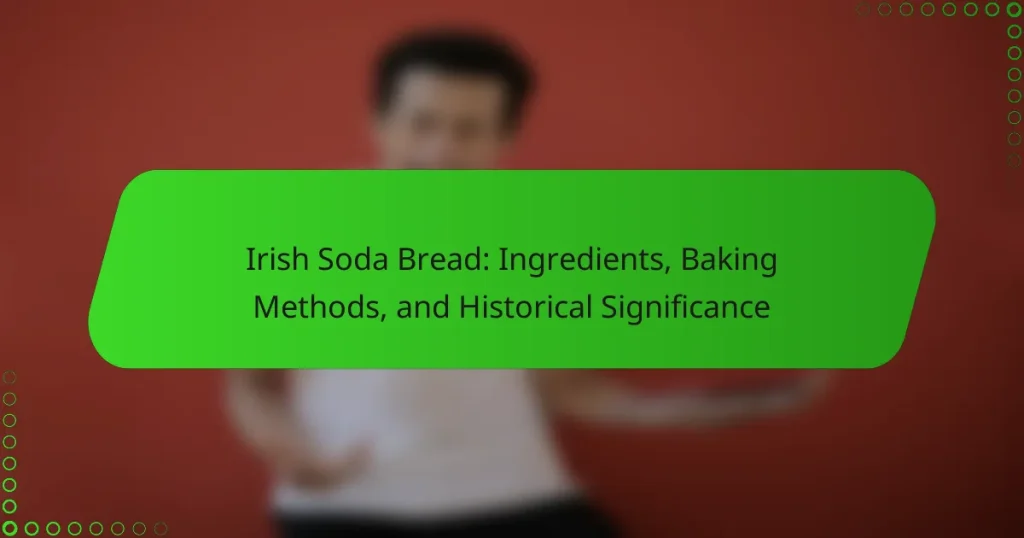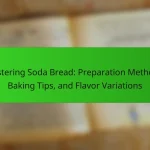Irish Soda Bread is a traditional Irish bread that uses baking soda as a leavening agent, distinguishing it from yeast-based breads. The main ingredients include flour, baking soda, salt, and buttermilk, which react to create carbon dioxide, resulting in a dense yet soft texture. This bread became popular in the 19th century, especially during the Great Famine, due to its simplicity and the accessibility of its ingredients. Two primary baking methods exist: oven baking and skillet baking, each yielding a unique texture and flavor. Irish Soda Bread not only serves as a staple in Irish cuisine but also reflects cultural identity and historical significance, symbolizing resilience and resourcefulness in Irish culinary traditions.

What is Irish Soda Bread?
Irish Soda Bread is a traditional Irish bread made using baking soda as a leavening agent. This method differs from yeast-based breads, which require fermentation. The primary ingredients include flour, baking soda, salt, and buttermilk. The use of buttermilk provides acidity, which reacts with baking soda to create carbon dioxide. This reaction results in a dense, yet soft texture. Historically, Irish Soda Bread became popular in the 19th century due to its simplicity and the availability of ingredients. It was often baked on a griddle or in a cast-iron pot. Today, it remains a staple in Irish cuisine and is enjoyed worldwide.
How is Irish Soda Bread different from other types of bread?
Irish Soda Bread differs from other types of bread primarily due to its use of baking soda as a leavening agent instead of yeast. This results in a quicker preparation process. Traditional Irish Soda Bread typically contains only four main ingredients: flour, baking soda, salt, and buttermilk. The absence of yeast means it does not require time to rise. This bread has a dense texture and a slightly tangy flavor from the buttermilk. Historically, it originated in Ireland during the 19th century, reflecting the local ingredients available. The simplicity of its ingredients and method made it a staple in Irish households.
What are the key ingredients that define Irish Soda Bread?
The key ingredients that define Irish Soda Bread are flour, baking soda, salt, and buttermilk. Flour serves as the primary base, typically all-purpose or whole wheat. Baking soda acts as the leavening agent, creating a rise without yeast. Salt enhances flavor and balances the bread’s taste. Buttermilk provides acidity, which reacts with baking soda to produce carbon dioxide. This reaction is essential for the bread’s unique texture. Traditional recipes may also include additional ingredients like raisins or caraway seeds, but the core ingredients remain consistent.
What role does baking soda play in the leavening process?
Baking soda acts as a leavening agent in the baking process. It produces carbon dioxide gas when it reacts with an acid. This gas forms bubbles in the dough, causing it to rise. Common acids used with baking soda include buttermilk or vinegar. The reaction begins as soon as the ingredients are mixed. This creates a light and airy texture in baked goods. In Irish soda bread, baking soda replaces yeast. This method allows for a quicker baking process.
What are the traditional variations of Irish Soda Bread?
Traditional variations of Irish Soda Bread include brown soda bread, white soda bread, and soda farls. Brown soda bread uses wholemeal flour, providing a denser texture and richer flavor. White soda bread is made with refined flour, resulting in a lighter and softer loaf. Soda farls are flat, round pieces of bread, cooked on a griddle. Each variation reflects regional preferences and available ingredients in Ireland. Historically, these breads were staples in Irish households, showcasing the simplicity and resourcefulness of traditional Irish baking.
How do different regions of Ireland influence the recipe?
Different regions of Ireland significantly influence the recipe for Irish soda bread. Each region utilizes local ingredients and traditional baking methods. For instance, Northern Ireland often incorporates wholemeal flour, giving the bread a denser texture. In contrast, the south tends to use white flour, resulting in a lighter loaf.
Regional variations also reflect cultural influences. Coastal areas may include seaweed or oats, while inland regions might use buttermilk for moisture and flavor. Historical practices shape these recipes, as families pass down techniques unique to their locality.
Moreover, the availability of ingredients impacts the recipe. For example, in areas with abundant dairy farms, buttermilk is a common ingredient. This diversity in ingredients and methods showcases the rich culinary heritage of Ireland.
What unique ingredients might be used in specific variations?
Unique ingredients in specific variations of Irish soda bread include buttermilk, caraway seeds, and raisins. Buttermilk is a traditional leavening agent that reacts with baking soda. Caraway seeds add a distinctive flavor and are often found in Northern Irish recipes. Raisins or currants are common in sweeter versions, particularly in soda bread served during festive occasions. Some variations may incorporate herbs like rosemary or thyme for a savory twist. Other unique ingredients can include oats or whole wheat flour for added texture and nutrition. Each variation reflects regional preferences and historical influences on the recipe.

What are the baking methods for Irish Soda Bread?
Irish Soda Bread can be baked using two primary methods: oven baking and skillet baking. Oven baking involves preheating the oven to 425°F (220°C) and placing the shaped dough on a baking sheet. The bread is baked for about 30 minutes until it is golden brown and sounds hollow when tapped. Skillet baking is an alternative method where the dough is cooked in a heavy skillet over low to medium heat. This method typically takes about 20-25 minutes, allowing for a crusty exterior while ensuring the inside is fully cooked. Both methods yield a traditional Irish Soda Bread with a unique texture and flavor.
How can Irish Soda Bread be baked at home?
To bake Irish Soda Bread at home, start by preheating your oven to 425°F (220°C). Combine 4 cups of all-purpose flour, 1 teaspoon of baking soda, and 1 teaspoon of salt in a mixing bowl. Create a well in the center and pour in 1 ¾ cups of buttermilk. Mix until a soft dough forms. Turn the dough onto a floured surface and knead gently for about one minute. Shape the dough into a round loaf and place it on a baking sheet. Cut a cross on the top of the loaf to help it rise. Bake for 30-35 minutes until the bread is golden brown and sounds hollow when tapped on the bottom. Let it cool before slicing. This method reflects traditional practices, making use of simple ingredients and quick preparation.
What are the essential steps in preparing the dough?
The essential steps in preparing the dough for Irish soda bread include mixing the dry ingredients, adding the wet ingredients, and kneading the dough. First, combine flour, baking soda, and salt in a bowl. This mixture forms the dry base of the dough. Next, create a well in the center and pour in buttermilk. The acid in buttermilk reacts with baking soda, aiding in leavening. Mix until a soft dough forms, ensuring not to overwork it. Then, turn the dough onto a floured surface. Knead gently for a short time, about 30 seconds, to bring it together. Finally, shape the dough into a round loaf and cut a cross on top to allow for expansion during baking. These steps ensure the bread rises properly and has the desired texture.
How does the baking temperature affect the final product?
Baking temperature significantly influences the final product of Irish soda bread. Higher temperatures can create a crustier exterior while maintaining a soft interior. Conversely, lower temperatures may result in a denser and less developed crust. The Maillard reaction, which enhances flavor and color, occurs more effectively at higher temperatures. Research indicates that optimal baking occurs around 425°F (220°C) for soda bread. This temperature allows for proper rising and texture development, ensuring the bread is light and airy.
What common mistakes should be avoided when baking Irish Soda Bread?
Common mistakes to avoid when baking Irish Soda Bread include using the wrong flour type. All-purpose flour can lead to a denser bread. Instead, use a combination of all-purpose and whole wheat flour for better texture. Another mistake is over-kneading the dough. Knead just until combined to keep the bread light. Not measuring ingredients accurately can also affect the outcome. Use a kitchen scale for precision. Additionally, not allowing the baking soda to activate properly can result in poor rising. Mix the baking soda with buttermilk immediately before combining with dry ingredients. Finally, avoid opening the oven door too often while baking. This can cause temperature fluctuations, affecting the bread’s rise.
How can one ensure the bread rises properly?
To ensure bread rises properly, use the correct ratio of baking soda to flour. Typically, one teaspoon of baking soda is used for every cup of flour. This ratio activates the leavening process when combined with an acidic ingredient like buttermilk. Mix the dry ingredients thoroughly before adding wet ingredients. Knead the dough gently for about 30 seconds to form gluten without overworking it. Allow the dough to rest for a few minutes before shaping. Bake the bread in a preheated oven at the right temperature, usually around 425°F (220°C). This ensures the bread rises well due to the heat activating the baking soda.
What are the signs of overbaking or underbaking?
Overbaking results in a dry, hard texture and a dark, crusty exterior. Underbaking leads to a wet, doughy center and a pale appearance. Overbaked Irish soda bread may crack excessively on the surface. It can also have a burnt smell. Underbaked bread often collapses when sliced. A toothpick test can confirm doneness; it should come out clean when baked properly. These signs are essential for achieving the ideal texture and flavor in Irish soda bread.

What is the historical significance of Irish Soda Bread?
Irish Soda Bread holds historical significance as a staple food in Ireland, particularly during the 19th century. It emerged as a practical solution for the impoverished population, especially during the Great Famine from 1845 to 1852. The bread’s primary ingredients—baking soda, buttermilk, and flour—were affordable and readily available. This allowed families to prepare a nutritious food source with minimal resources.
Irish Soda Bread also reflects cultural identity and traditions. It is often associated with Irish hospitality and was commonly served during gatherings and celebrations. The bread’s unique preparation method, which does not require yeast, showcases the ingenuity of Irish homemakers in adapting to local conditions.
Overall, Irish Soda Bread symbolizes resilience, resourcefulness, and the rich culinary heritage of Ireland. Its enduring presence in Irish cuisine highlights its importance in both historical and cultural contexts.
How did Irish Soda Bread originate?
Irish Soda Bread originated in Ireland during the 19th century. It was developed as a quick bread using baking soda as a leavening agent. Traditional methods utilized simple ingredients like flour, baking soda, salt, and buttermilk. The introduction of baking soda made bread-making faster and more accessible. This method became essential due to the scarcity of yeast and the need for quick preparation. Irish Soda Bread reflects the resourcefulness of Irish households. It became a staple in many Irish diets, especially in rural areas. The bread’s unique texture and flavor arise from the reaction between baking soda and buttermilk.
What cultural factors contributed to its development?
Irish Soda Bread developed due to cultural factors like resource scarcity and traditional baking practices. The use of baking soda became essential in the 19th century. This was a time when yeast was less accessible. The reliance on local ingredients, such as buttermilk and flour, shaped the recipe. Irish families often baked bread daily, making it a staple food. The communal aspect of bread-making reinforced social bonds. Additionally, the influence of Irish heritage and identity played a significant role. Bread was often associated with hospitality and cultural gatherings. These factors collectively contributed to the evolution of Irish Soda Bread.
How has the recipe evolved over time?
The recipe for Irish Soda Bread has evolved significantly over time. Originally, it was made with just four basic ingredients: flour, baking soda, salt, and buttermilk. This simplicity was due to the availability of ingredients in rural Ireland. Over the years, variations emerged, incorporating additional ingredients such as raisins, caraway seeds, and even eggs. These adaptations reflect regional tastes and the influence of different cultures. In the 19th century, the introduction of commercial baking soda changed the leavening process, making it more accessible. Today, recipes often include whole wheat flour and various flavorings, showcasing a blend of traditional and modern culinary practices. The evolution mirrors changes in agricultural practices, dietary preferences, and globalization.
What role does Irish Soda Bread play in Irish culture today?
Irish Soda Bread is a staple in contemporary Irish culture. It symbolizes tradition and community in Ireland. Families often bake it at home, especially during holidays and gatherings. The bread is frequently served with meals, reflecting its importance in daily life. It is also featured in cultural events and festivals, showcasing Irish heritage. Many Irish people associate the bread with comfort and nostalgia. Its simple ingredients highlight the resourcefulness of Irish cooking. Overall, Irish Soda Bread remains a cherished element of Irish identity today.
How is it traditionally served during special occasions?
Irish soda bread is traditionally served during special occasions such as St. Patrick’s Day and Easter. It is often accompanied by butter, jam, or honey. In some households, it is paired with meals like corned beef and cabbage. The bread’s round shape symbolizes the sun and is a representation of unity. On special occasions, it may be baked with added ingredients like raisins or caraway seeds for enhanced flavor. This variation reflects regional customs and family recipes passed down through generations. The tradition of serving Irish soda bread highlights its cultural significance in Irish heritage.
What significance does it hold in Irish hospitality?
Irish soda bread holds significant cultural importance in Irish hospitality. It symbolizes warmth and welcome in Irish homes. Traditionally, it is served to guests as a gesture of hospitality. The bread’s simplicity reflects the resourcefulness of Irish people. It is often baked fresh daily, emphasizing the value placed on home-cooked meals. In social gatherings, sharing soda bread fosters community and connection. Historical records show that it has been a staple in Irish diets since the 19th century. This longstanding tradition enhances its role in hospitality, making it a cherished element of Irish culture.
What are some tips for making the best Irish Soda Bread?
Use fresh ingredients for the best Irish Soda Bread. Fresh flour and baking soda ensure proper rising. Mix the dry ingredients thoroughly before adding wet ingredients. This helps to evenly distribute the baking soda. Use buttermilk for moisture and flavor. Buttermilk reacts with baking soda, enhancing the bread’s texture. Knead the dough gently; over-kneading can lead to a tough loaf. Shape the dough into a round before baking for even cooking. Bake in a preheated oven at 425°F for about 30 minutes. The bread should sound hollow when tapped on the bottom, indicating it’s done.
What are the best practices for ingredient selection?
The best practices for ingredient selection in Irish soda bread include using fresh, high-quality ingredients. Flour should be unbleached and ideally whole wheat for better flavor and nutrition. Baking soda must be fresh to ensure proper leavening. Buttermilk is preferred for its acidity, which activates the baking soda. Salt is essential for flavor enhancement. Avoid using expired or stale ingredients, as they can compromise the bread’s quality. Consistency in measuring ingredients is crucial for achieving the right texture. Following traditional ratios can also help maintain authenticity in flavor and structure.
How can one customize the recipe for personal taste?
One can customize the recipe for Irish soda bread by adjusting ingredients and proportions. For example, adding different types of flour can change the texture. Whole wheat flour provides a nuttier flavor. Incorporating ingredients like oats or seeds enhances nutritional value. Adjusting the amount of sugar can cater to personal sweetness preferences. Adding spices such as caraway seeds or herbs can introduce unique flavors. Experimenting with liquid types, such as buttermilk or yogurt, can alter the bread’s acidity and moisture. These modifications allow for a personalized taste experience while maintaining the core characteristics of Irish soda bread.
Irish Soda Bread is a traditional Irish bread characterized by its use of baking soda as a leavening agent, distinguishing it from yeast-based breads. The article covers its key ingredients—flour, baking soda, salt, and buttermilk—along with various baking methods, including oven and skillet baking. It also explores the historical significance of Irish Soda Bread, its regional variations, and cultural importance in Irish hospitality and celebrations. Additionally, the article provides tips for making the best Irish Soda Bread, including ingredient selection and customization options for personal taste.


